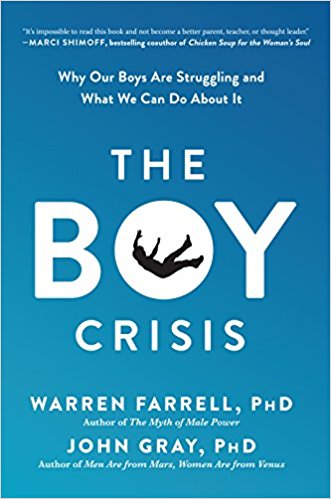![]()
Where the boys are
Academically, boys across the country are lagging behind the girls, but a Montreal public school has seen dramatic improvement by separating the sexes in classes. It allows teachers to tailor curriculum and style to suit each sex. The result? The number going on to college has nearly doubled. INGRID PERITZ reports
The Globe and Mail, by INGRID PERITZ, February 1, 2003 – Print Edition, Page F8
MONTREAL -- The teenage girls at James Lyng High School like to flirt with boys. They like to tease them, joke with them, even date them sometimes. But attend class with them? As the giggling girls in one math class this week might say, "Gross."
Luckily, they don't have to. Coed James Lyng splits boys and girls up at the classroom door. The division of the sexes is credited with helping turn a faltering inner-city high school into an education success story.
Same-sex schooling usually conjures up images of the morality-steeped 1950s or the grey-flannel private school set. But a handful of Quebec schools are poaching creatively from the elite-school world and forming his and her classes under a coed roof.
And they are being eyed across North America as a possible solution to gender differences in education --
one that is increasingly seeing boys lag behind girls. In every province in Canada, boys drop out at higher
rates than girls, fall behind in average reading scores and outrank girls in behavioural problems.
Part of the rationale will be obvious to anyone who can recall spending math class coveting a nearby member
of the opposite sex. Remove the ricocheting hormones, the theory goes, and adolescents may focus on
fractions instead of each other.
Surprisingly, the experiment has found many fans among students at James Lyng.
Boys at school say they've calmed down and quit putting on acts. Adam Henry, a sprouting 14-year-old with an eager and open manner, saw the inside of the principal's office on average twice a week in elementary school. He was always busy showing off for the girls in class, he says.
At James Lyng, he has been on the honour roll for two years running and plans to study computer science in college. "When the girls are there, you're distracted," he says in the school's bright, central atrium, where he was pasting up an exhibition on Ancient Egypt with another boy. "When it's just boys in the class, you work all the time, your marks go up, and you stay focused. You can concentrate a lot better. There are less distractions now. The girls don't bother you all the time."
Julie Henderson, a 16-year-old who scraped by in grade school, now plans to become the first member of her family to go to college. She feels that she discovered her potential in her all-girl class.
"Sometimes the boys have negative stuff to say about the girls. When you answer a question, they'll comment and say things to make you sound like you're dumb," she says. "Now, I don't have to worry about what boys think about me, so I can think better."
Putting boys and girls in a class of their own is hardly a new idea, although it fell out of fashion in Canada's public-school system decades ago. In Quebec, it was discarded as a relic of the church-dominated education system.
But teachers at James Lyng say same-sex classes have let them tailor their teaching to the sexes, lending credence to what the studies have suggested: Boys and girls learn and perform differently in the classroom. Findings suggest that girls lack confidence in math and science; boys lag behind girls in reading and writing.
In Klara Bourne's English class this week, the book being tackled was Animal Farm,George Orwell's fable about the failings of communism. When she teaches her class of girls, Ms. Bourne focuses on the "interpersonal relationships" and hierarchy among the animals.
For the boys, it's old-fashioned who-wins, who-loses stuff. Ms. Bourne concentrates on the power struggles
of the historical figures behind the book, Trotsky and Stalin, since that's what fascinates the boys, she
says. "It was obvious they needed this type of separating to blossom," she says.
The macho-power theme for boys and soft-personal theme for girls might all smack of old-style clichs. The
teachers swear it works. "The change is enormous," says the enthusiastic Ms. Bourne, who has 22 years'
experience. "Girls are a lot more timid in the presence of boys. They're extremely worried about the boys'
opinion. Once they're separated, the girls are more willing to explore ideas. They're a serious part of the
discussion, unlike before. And the boys don't need to posture in the classroom any more." As a result,
they're more attentive.
Dona Matthews, an educational psychologist at the University of Toronto, says girls do well in same-sex schooling, especially in math and sciences, where they tend to lack confidence around boys.
Boys fare better both socially and academically in coed schooling because they're given more respect and listened to more." Boys do better when there's more pressure, girls do better when there's less, she said.
Others agree that girls need a co-operative approach in the classroom, while boys need a competitive one.
Leonard Sax, a psychologist near Washington, D.C., says the argument for gender-based classrooms goes beyond removing the distractions of the opposite sex. "It's a matter of brain science," he says. Girls even hear better than boys, he claims.
Dr. Sax, a family physician, was seeing parents of school-aged boys fretting that their child suffered from attention deficit disorder. Too often, he found, the boy was sitting at the back of his class and couldn't hear what the teacher was saying.
Dr. Sax went on to found the National Association for the Advancement of Single Sex Public Education, part of a slow-growing movement to create public same-sex schools in the United States. He says a woman teacher speaking in a normal tone is barely audible to a boy at the back of the class.
"He would benefit from being in a boys-only classroom with a male teacher who will get in his face and scream at him," Dr. Sax says. "You wouldn't want to use that kind of confrontational approach with girls. That girl wouldn't speak for the rest of the year. Girls tend to see the teacher as an ally. Boys do not."
James Lyng turned to same-sex classes five years ago partly out of desperation. Class discipline had broken down. The school, stranded near a tangle of expressways in blue-collar Montreal, landed close to the basement in academic performance for the English-language system.
Principal Wayne Commeford saw a school full of students who didn't believe they could succeed and couldn't break out of their own self-styled stereotypes. "We were desperate to create an environment where both [girls and boys] were able to step back from the roles they were unconsciously living up to, or down to, as the case may be," he says. "We wanted to let them express themselves without the fear of being laughed at or embarrassed."
Same-sex classes didn't do it alone. James Lyng has been given a special designation that earns it $1.2-million in provincial funding over three years to reduce its dropout rate. The school focuses on teaching through projects and so-called core teaching, where one teacher stays with a group of students through several classes.
Today, absenteeism has dropped to 7 per cent from 20 per cent five years ago. About 80 per cent of students pass their final exams, up from 65 per cent. The rate of students going on to college has nearly doubled.
Is separating boys and girls really the answer? Critics say the move shelters kids at a vulnerable age from real-life social tensions. Others say it actually plays into gender stereotyping. Some studies suggest that it isn't the same-sex classes that work well at certain schools, but the extra attention from teachers that comes with it.
Either way, there is no going back at James Lyng, where the boys and girls have grown accustomed to being in a class apart. One teacher says her Grade 8 class of girls is so pleased with the status quo, they recently refused to invite a boys' class in to show off their spiffy class project. "Miss, if you let them in here," they said, "we won't talk."
Sounds like they've lost all interest in boys. At least until the bell rings.
Ingrid Peritz is a member of The Globe and Mail's Montreal bureau.
The case for single-sex classes
Research suggests the following benefits of segregating girls andboys in school:
Students can break free of gender stereotypes. Boys feel freer to pursue interests in art, music, drama and
foreign languages while girls are more likely to take advanced math, physics and information technology.
Boys are freer to express enthusiasm.
Bullying will be reduced.
A curriculum can be tailored to different learning styles. Girls seem to do better with a collaborative approach while boys respond to a louder more lively style, even confrontational.
In a coed setting, receiving an A lowers a boy's status with other boys.





